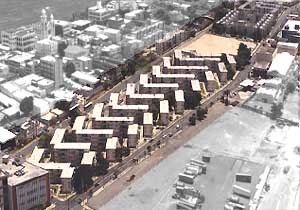Major improvements for Puerta de
Tierra public housing residents
CARIBBEAN BUSINESS
By : CB STAFF
Volume: 35 | No: 38
Page : B38-B39
Issued : 09/27/2007 |
|

|
|
|
Residencial Puerta de Tierra |
Through the efforts of the Puerto Rico Housing
Department and the Public Housing Administration, public housing in the
San Juan Puerta de Tierra waterfront district will have a whole new look.
“What we’re trying to do here is something different from the typical
modernization projects we usually do in public housing,” said Jorge
Rivera, secretary of the Puerto Rico Housing Department. “This is what
we call a demonstration urban project and it will create a lot of new
opportunities not only for the residents but for the entire waterfront
district as a whole.”
He explained that while the current public housing facility in Puerta de
Tierra consists of one huge lot that stands as a barrier between the
waterfront parcels and the rest of the community, the new development
plan has the area subdivided into four parcels that will provide three
new access areas from the north to the south to connect the property to
other sections of the area and make it a more walkable community. “Not
only are we taking away the big walls that currently separate this
community from the others but we will be providing walkable lots that
allow interaction among various income levels,” said Carlos Laboy,
director of the Public Housing Administration. “Imagine coming from
Hacienda and you can walk all the way from Puerta de Tierra to Club
Náutico.” He added that the new concept, which is currently in the
design phase, has been also used for public housing in other cities
throughout the U.S., such as San Francisco and Oakland. “This is what we
call the new phase of public housing,” he added.
And while the buildings in the current housing project are positioned
diagonally to the sidewalks, the new structures will be parallel to
resemble typical city streets. In addition, the new complex will contain
an exclusive building to house the elderly, with doctors and medical
professionals located nearby.
In addition to the new structures, one of the most exciting features of
the redesigned project involves the wide range of opportunities it will
create for residents. “In addition to the residential units, this new
concept will also include as many as 65 commercial spaces that will
provide a number of benefits for the residents,” said Rivera. He
explained the concept is twofold. First, by including a number of much-needed
businesses in the complex, such as a 24/7 pharmacy, convenience stores,
services and eateries, the residents would be able to get what they need
without leaving the area. “Right now, there is no pharmacy between
Miramar and Old San Juan,” said Rivera. “This new project will provide
the necessary services to that community.” He also said these businesses
could provide employment opportunities to the residents as well.
And while some of the commercial spaces will be used to house
established mainstream businesses, others will serve to open doors for
residents to start their own businesses and sell their services and
wares to residents and visitors alike. “We have a program within Public
Housing that provides residents with the necessary tools to establish
their own businesses,” said Laboy. “We provide them with the training
and many have become successful entrepreneurs as a result.” He explained
that through the Public Housing Administration an economic development
program was created whereby programs and initiatives are developed to
harness the skills of public housing residents throughout the island and
help them use these skills to establish their own microcompanies. By
providing assistance in areas, such as the preparation of business plans,
selling strategies, pricing, insurance, permits, etc., residents have
the opportunity to develop and grow in a number of areas. “Not only does
the program facilitate the economic independence of the residents, it
also helps to improve the quality of life for them and their families,”
said Laboy.
In the case of the Puerta de Tierra project, many of the commercial
spaces will be used to house these microcompanies. “Our goal is to give
these residents the opportunity to rent these store-front spaces,” said
Laboy. “Not only will it give residents a place to sell their goods but
it would create a street-mall atmosphere that will make it a more active
tourist area as well.” There are currently more than 50 Pridco-(Puerto
Rico Industrial Development Co.) certified resident arts and crafts
vendors, who have resident-owned businesses with some even participating
in various trade fairs, such as the one held by the Hispanic Chamber of
Commerce to sell handmade clothing, pottery, jewelry and other sought-after
items.
In addition to the Puerta de Tierra megaproject, similar projects are
being planned for other parts of the island, including Mayagüez, where
the new concept will be applied to a project in front of the park where
the 2010 Caribbean games will be held. Similar to the San Juan
waterfront design, this will also contain commercial spaces and a tower
for the elderly.
Among other projects planned for the Mayagüez region, Rivera and Laboy
also talked about the new Boys and Girls Clubs’ recreational facility,
which will be the largest in the nation and will feature a swimming pool
and a host of recreational amenities. “The Boys and Girls Clubs of
America was very impressed by our commitment to this project,” said
Laboy. “They have become one of our best partners and they will be
managing the facility once it is built.” He also said proven experience
shows that when these kinds of facilities are provided to public housing
residents and the community in general, there is less of a need to
increase police forces in those districts.
